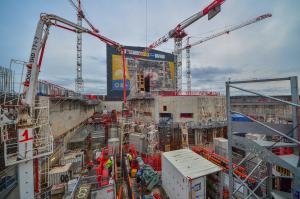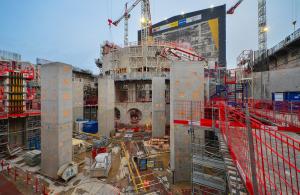The undressing of the bioshield
More than two years ago in October 2015, concrete pouring began for one of the most striking structures of the entire construction site: the ITER bioshield, a massive cylindrical fortress that surrounds the machine and protects workers and the environment from the radiation generated by fusion reactions.
As construction progressed, the nest-like structure became the defining feature of Tokamak Complex construction and an icon for the project as a whole. Pictures of the bioshield—taken from above in the slanted late evening light by drone or from a crane—have been a favourite of the media for the past two years.
Now, the bioshield is fully formed and this equipment is not needed anymore. The structure is bare and its anatomy, now revealed, helps us better understand its function—how, for instance, penetrations of all sizes and shapes will allow neutral beam injectors, diagnostic systems and remote handling machinery to reach the heart of the machine.



